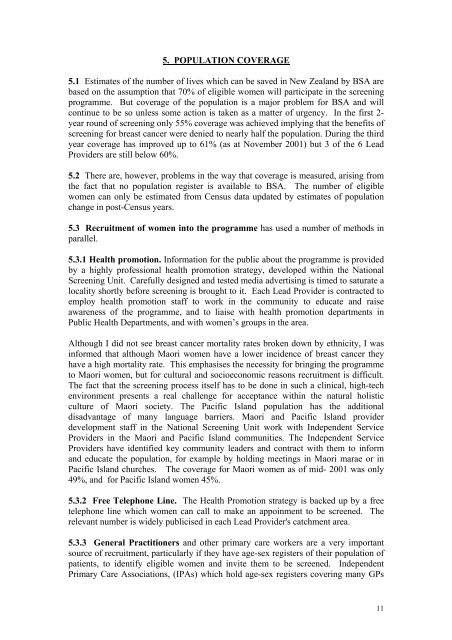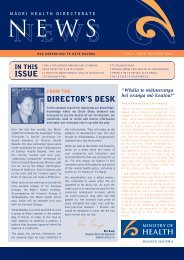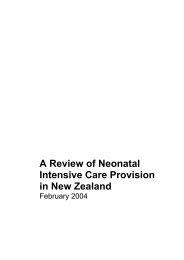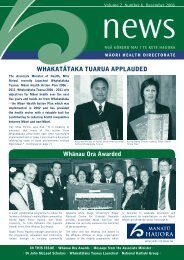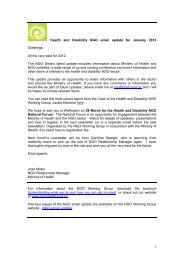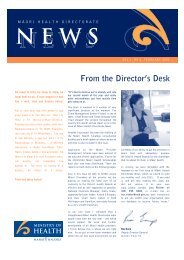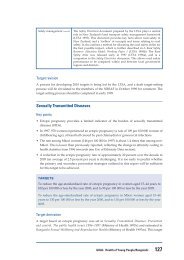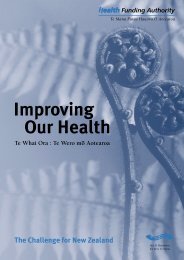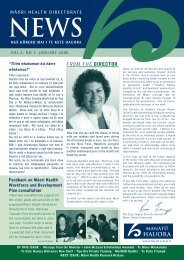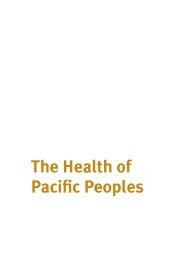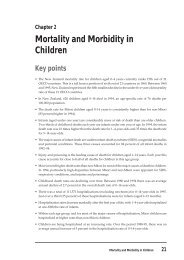breastscreen aotearoa an independent review - Ministry of Health
breastscreen aotearoa an independent review - Ministry of Health
breastscreen aotearoa an independent review - Ministry of Health
Create successful ePaper yourself
Turn your PDF publications into a flip-book with our unique Google optimized e-Paper software.
5. POPULATION COVERAGE5.1 Estimates <strong>of</strong> the number <strong>of</strong> lives which c<strong>an</strong> be saved in New Zeal<strong>an</strong>d by BSA arebased on the assumption that 70% <strong>of</strong> eligible women will participate in the screeningprogramme. But coverage <strong>of</strong> the population is a major problem for BSA <strong>an</strong>d willcontinue to be so unless some action is taken as a matter <strong>of</strong> urgency. In the first 2-year round <strong>of</strong> screening only 55% coverage was achieved implying that the benefits <strong>of</strong>screening for breast c<strong>an</strong>cer were denied to nearly half the population. During the thirdyear coverage has improved up to 61% (as at November 2001) but 3 <strong>of</strong> the 6 LeadProviders are still below 60%.5.2 There are, however, problems in the way that coverage is measured, arising fromthe fact that no population register is available to BSA. The number <strong>of</strong> eligiblewomen c<strong>an</strong> only be estimated from Census data updated by estimates <strong>of</strong> populationch<strong>an</strong>ge in post-Census years.5.3 Recruitment <strong>of</strong> women into the programme has used a number <strong>of</strong> methods inparallel.5.3.1 <strong>Health</strong> promotion. Information for the public about the programme is providedby a highly pr<strong>of</strong>essional health promotion strategy, developed within the NationalScreening Unit. Carefully designed <strong>an</strong>d tested media advertising is timed to saturate alocality shortly before screening is brought to it. Each Lead Provider is contracted toemploy health promotion staff to work in the community to educate <strong>an</strong>d raiseawareness <strong>of</strong> the programme, <strong>an</strong>d to liaise with health promotion departments inPublic <strong>Health</strong> Departments, <strong>an</strong>d with women’s groups in the area.Although I did not see breast c<strong>an</strong>cer mortality rates broken down by ethnicity, I wasinformed that although Maori women have a lower incidence <strong>of</strong> breast c<strong>an</strong>cer theyhave a high mortality rate. This emphasises the necessity for bringing the programmeto Maori women, but for cultural <strong>an</strong>d socioeconomic reasons recruitment is difficult.The fact that the screening process itself has to be done in such a clinical, high-techenvironment presents a real challenge for accept<strong>an</strong>ce within the natural holisticculture <strong>of</strong> Maori society. The Pacific Isl<strong>an</strong>d population has the additionaldisadv<strong>an</strong>tage <strong>of</strong> m<strong>an</strong>y l<strong>an</strong>guage barriers. Maori <strong>an</strong>d Pacific Isl<strong>an</strong>d providerdevelopment staff in the National Screening Unit work with Independent ServiceProviders in the Maori <strong>an</strong>d Pacific Isl<strong>an</strong>d communities. The Independent ServiceProviders have identified key community leaders <strong>an</strong>d contract with them to inform<strong>an</strong>d educate the population, for example by holding meetings in Maori marae or inPacific Isl<strong>an</strong>d churches. The coverage for Maori women as <strong>of</strong> mid- 2001 was only49%, <strong>an</strong>d for Pacific Isl<strong>an</strong>d women 45%.5.3.2 Free Telephone Line. The <strong>Health</strong> Promotion strategy is backed up by a freetelephone line which women c<strong>an</strong> call to make <strong>an</strong> appoinment to be screened. Therelev<strong>an</strong>t number is widely publicised in each Lead Provider's catchment area.5.3.3 General Practitioners <strong>an</strong>d other primary care workers are a very import<strong>an</strong>tsource <strong>of</strong> recruitment, particularly if they have age-sex registers <strong>of</strong> their population <strong>of</strong>patients, to identify eligible women <strong>an</strong>d invite them to be screened. IndependentPrimary Care Associations, (IPAs) which hold age-sex registers covering m<strong>an</strong>y GPs11


